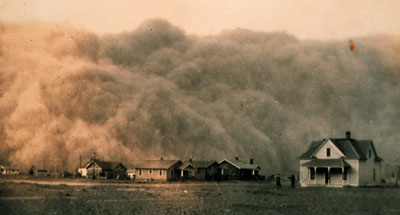The Dust Bowl was an environmental disaster of epic proportions. It was caused by unsustainable agricultural practices during a time of drought. It changed the face of farming in the United States forever.
 |
A dust storm billows through Stratford Texas in 1935. In some areas, immense rolling dust clouds reached as high as 8,000 feet into the sky (Source: Letters from the Dust Bowl). Photo by George E. Marsh, courtesy of NOAA. |
It happened in the 1930s, in the midst of the Great Depression. But events leading up to it began with the passage of The Homestead Act after the Civil War. Pioneers were encouraged to move westward, lured by advertisements depicting a bountiful Garden of Eden where grapes grew to the size of bowling balls and watermelons became as big as automobiles.
In years when rain was plentiful, the flatland of the southern Great Plains was a productive place. But suitcase farmers brought agricultural practices of the North and East to the semi-arid land where relentless winds and intense summer heat were the rule. World War I drove demand and prices for wheat to record highs. More and more perennial native grasses with tough roots that held soil in place were replaced with annual crops of wheat. Fields were plowed deep and left bare after harvest, or stubble was burned, exposing the depleted soil to winter winds. Modern technology accelerated the transformation in the 1920s. A farmer with a team of horses would be happy to plow three acres a day. With a tractor, he could easily plow 50 acres a day.
Then in 1931, a severe drought began. It lasted for eight years. Farmers kept on plowing and planting, but nothing grew. Vegetation shriveled up in a circle encompassing the panhandles of Texas and Oklahoma, western Kansas, and central Colorado and New Mexico. In 1932, there were 14 dust storms; in 1933 there were 38, and they kept on coming. When the “rain quit and the wind got high, the black ol’ dust storm filled the sky…. It turned my farm into a pile of sand,” lamented Woody Guthrie in his Dust Bowl Ballads.
“It had taken a thousand years to build an inch of topsoil on the Southern Plains. It took only minutes for one good blow to sweep it all away,” notes the PBS film Surviving the Dust Bowl. By 1934, an estimated 850 million tons of topsoil left 100 million acres of land in America’s heartland. (Source: 1934 Yearbook of Agriculture) The dust even landed on the decks of ships 300 miles off of the eastern seaboard. (Source: NRCS)
Houses and tractors were buried in the drifting dirt. It was nearly impossible to keep houses clean. People were constantly spitting out gritty dirt that looked like tobacco juice. Many were sickened with “dust pneumonia.” Roosters crowed, and chickens went to roost in the daytime darkness.
Wildlife was affected too. On the outskirts of Amarillo, Texas, a crow’s nest was found constructed entirely of barbed wire, since no other materials were available on the lifeless land. In the face of an avalanche of dust, “smaller birds fly until they are exhausted, then fall to the ground, to share the fate of the thousands of jack rabbits which perish from suffocation,” recounted Lawrence Svobida, a wheat farmer in Kansas. Animals were not the only ones to flee. Hundreds and thousands of dust bowl refugees left the dry and dusty wasteland in search of work farther west.
The healing began when the federal government, under Franklin Delano Roosevelt, started promoting and subsidizing soil conservation. After a “Black Blizzard” blotted out the midday sun in New York and Washington DC in April of 1935, Congress declared soil erosion a national menace. The Soil Conservation Service, which ultimately morphed into the Natural Resource Conservation Service, was founded. Farmers and the Civilian Conservation Corps planted 200 million trees in a shelterbelt extending from Canada to Texas. The trees helped hold water and soil and break up the wind. Educational programs on erosion control promoted crop rotation, strip farming, contour plowing and terracing. Government propaganda and bribery were used to encourage change. Poverty-stricken farmers were paid $1.00 an acre to practice one of the new methods. They were also paid to reduce production of surplus crops like wheat. The Taylor Grazing Act passed in 1934 to prevent overgrazing and soil deterioration on public lands. By 1938, conservation efforts had reduced blowing soil by 65%. (Source: PBS).
Finally the rains came in 1939. However, soil conservation programs and practices, and the system of federal farm policy price supports and subsidies that sprouted during the Depression and Dust Bowl continue to this day.
|

